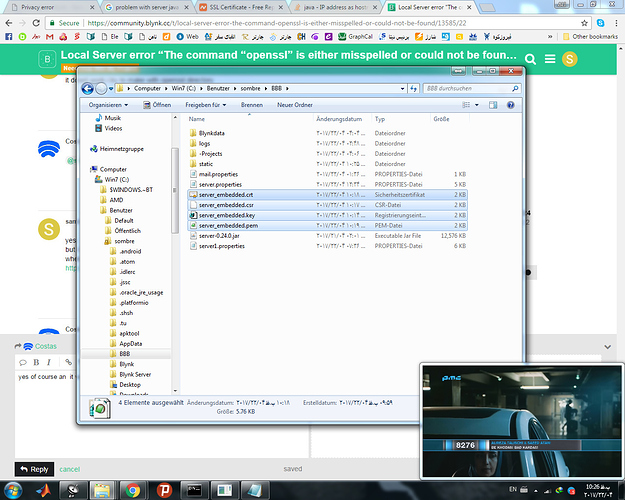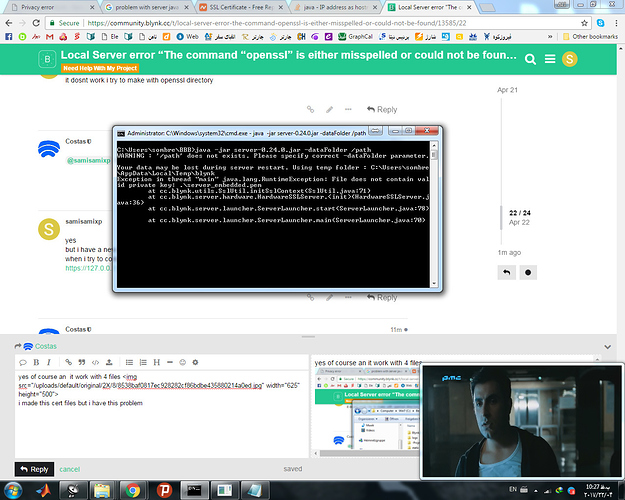it dosnt work i try to make with openssl directory
@samisamixp does it work in the OpenSSL directory?
yes
but i have a new problem with this address https://192.168.1.2:9443/admin
when i try to connect with my client address same up it dosnt wort but when i try with local ip https://127.0.0.1:9443/admin it work ---------- so what?
Have you created a server.properties file?
yes of course an it work with 4 files
i made this cert files but i have this problem
so i use this codes
openssl genrsa -out server_embedded.key 2048
openssl req -new -out server_embedded.csr -key server_embedded.key -config “Location of Config File”
openssl x509 -req -days 1500 -in server_embedded.csr -signkey server_embedded.key -out server_embedded.crt
openssl pkcs8 -topk8 -inform PEM -outform PEM -in server_embedded.key -out server_embedded.pem
so when i remove the pem file it work with local ip (127.0.0.1).
server.properties
#hardware ssl port
hardware.ssl.port=8441
#hardware plain tcp/ip port
hardware.default.port=8442
#http port
http.port=80
#web sockets ssl port
ssl.websocket.port=8081
#web sockets plain tcp port
tcp.websocket.port=8082
#https port
https.port=9443
#application ssl port
app.ssl.port=8443
#by default server uses embedded in jar cert to simplify local server installation.
#WARNNING DO NOT USE THIS CERTIFICATES ON PRODUCTION OR IN WHERE ENVIRNOMENTS REAL SECURITY REQUIRED.
#provide either full path to files either use ‘.’ for specifying current directory. For instance “./myfile.crt”
server.host=
server.ssl.cert=./server_embedded.crt
server.ssl.key=./server_embedded.pem
server.ssl.key.pass=
#Blynk server allows to use 2 hosts for same IP, below properties for second host
server2.host=
server2.ssl.cert=./server_embedded.crt
server2.ssl.key=./server_embedded.pem
server2.ssl.key.pass=
client.ssl.cert=
client.ssl.key=
#by default System.getProperty(“java.io.tmpdir”)/blynk used
data.folder=
#folder for logs.
logs.folder=./logs
#log debug level. trace|debug|info|error. Defines how precise logging will be.
log.level=info
#defines maximum allowed number of user dashboards. Needed to limit possible number of tokens.
user.dashboard.max.limit=10
#defines maximum allowed widget size in KBs as json string.
user.widget.max.size.limit=10
#user is limited with 100 messages per second.
user.message.quota.limit=100
#in case of consistent quota limit exceed during long term, sending warning response back to exceeding channel
#for performance reason sending only 1 message within interval. In millis
user.message.quota.limit.exceeded.warning.period=60000
#maximum allowed number of notification queue. Queue responsible for processing email, pushes, twits sending.
#Because of performance issue - those queue is processed in separate thread, this is required due
#to blocking nature of all above operations. Usually limit shouldn’t be reached.
notifications.queue.limit=10000
#Number of threads for performing blocking operations - push, twits, emails, db queries.
#Recommended to hold this value low unless you have to perform a lot of blocking operations.
blocking.processor.thread.pool.limit=5
#this setting defines how often we can send mail/tweet/push or any other notification. Specified in seconds
notifications.frequency.user.quota.limit=60
#maximum size of user profile in kb’s
user.profile.max.size=128
#period in millis for saving all user DB to disk.
profile.save.worker.period=60000
#period in millis for saving stats to disk.
stats.print.worker.period=60000
#specifies maximum period of time when application socket could be idle. After which
#socket will be closed due to non activity. In seconds. Default value 600 if not provided.
#leave it empty for infinity timeout
app.socket.idle.timeout=600
#specifies maximum period of time when hardware socket could be idle. After which
#socket will be closed due to non activity. In seconds. Default value 15 if not provided.
#leave it empty for infinity timeout
hard.socket.idle.timeout=15
#Enables native socket transport for Linux using JNI. Should be turned on only if you 100% sure.
#may not work on some environments. Used to increase server performance. Performance boost is ~20-40%.
enable.native.epoll.transport=false
#Enabled native openSSL support for SSL handlers. Should be turned on only if you 100% sure.
#may not work on some environments. Used to increase server performance. Performance boost is ~16%.
#For more details see - http://netty.io/wiki/forked-tomcat-native.html
enable.native.openssl=false
#mostly required for local servers setup in case user want to log raw data in CSV format
#from his hardware
enable.raw.data.store=true
#size of async logger ring buffer. should be increased for loads >2-3k req/sec
async.logger.ring.buffer.size=8192
#ADMINISTRATION SECTION
admin.rootPath=/admin
#administration https port
administration.https.port=7443
#reset pass port
reset.pass.http.port=7444
#host for reset pass redirect. by default current server IP is taken. could be replaced with more friendly hostname.
#it is recommended to override this property with your server IP to avoid possible problems of host resolving
reset-pass.http.host=blynk-cloud.com
#comma separated list of administrator IPs. allow access to admin UI only for those IPs.
#you may set it for 0.0.0.0/0 to allow access for all.
#you may use CIDR notation. For instance, 192.168.0.53/24
allowed.administrator.ips=127.0.0.1
#comma separated list of users allowed to create accounts. leave it empty if no restriction required.
allowed.users.list=
Is that the latest version of server.properties as I don’t see the login credentials for the login page that should now appear when you request the admin url?
no cause the laatest server.properties have error and dont be connect but old version have this problem
hey you are the best it work i edit the file and add allow new ip.
SOLVED
Glad you got it fixed. You should always use the latest version of everything unless you have a very good reason not to.
Simply saying latest version has errors, when nobody else seems to have a problem, suggests you have the problem, not the software.
I’m sure there are many others not updating their server.properties file but it’s something you should do with each new version of the server.

